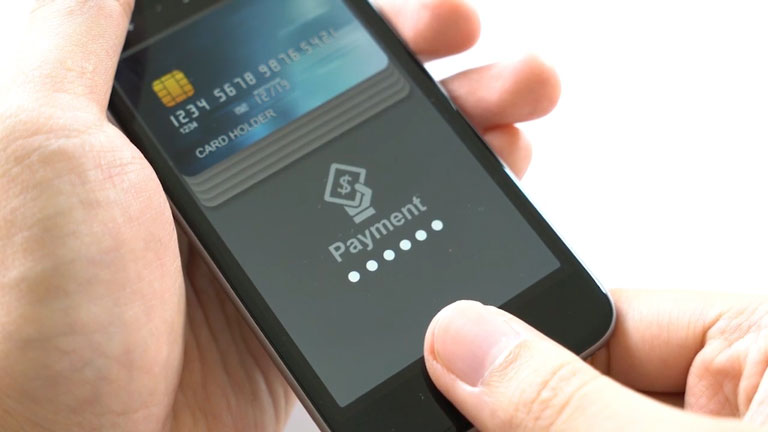After failing to come to agreement with Apple to enable mobile phone payments, six of Australia’s biggest financial institutions this week signed on with Android Pay. The service will go live in Australia in the first half of 2016.
Both Android Pay and its competitor Apple Pay allow consumers to pay for purchases using a card-linked mobile phone by tapping their phone in the same way you would tap your card at the point of sale. The services also work with smart watch devices, and in the case of Apple Pay, by holding the fingerprint on the phone.
Apple Pay had first mover advantage in the mobile payments space, having launched in the US in October 2014 and then in Britain in July 2015, before entering the Australian market this November.
To achieve traction in the US Apple Pay relied on the major American payment card issuers, earning money by taking a slice of the interchange fees that American card issuers gained from merchants. Interchange fees in the US average out at about US$1 for every US$100 of transactions and Apple Pay is believed to earn about US15 cents on every US$100 of transactions.
Apple Pay had been asking for the same slice of the interchange fees that are earned by the card issuers in other countries. In Britain the banks were able to negotiate Apple Pay’s slice to a much lower fee, believed to be only a few pence per one pound transaction, partially because interchange fees in Britain are much lower than in the US. Apple Pay originally wanted the same 15 cents for every $100 spent on its platform in Australia. But Australia’s main banks would not agree to this, given interchange fees in Australia are on average 50 cents for every $100 spent.
Apple Pay boxed in
When Apple Pay finally launched in Australia it was in tandem with American Express, which at that time was not subject to the RBA imposed interchange fees that applied to MasterCard and Visa payment cards. Since then the RBA’s Review of Card Payments Regulation suggested bringing so-called American Express “companion cards” into the interchange regulatory fold. This would make them subject to the same interchange fee cap as MasterCard and Visa. This would help the RBA to achieve its aim of “competitive neutrality” between the various card schemes.
At first Apple Pay’s choice of American Express seemed like a good one. American Express has around 6.8 million credit and charge cards in circulation, of the total of around 42 million payment cards in Australia. But Apple Pay can only be used on American Express’s “proprietary” cards (not on its “companion cards”) and an RBA survey in 2014 found companion cards are now more widely held than American Express proprietary cards. So in reality Apple Pay can only be used on a minority of American Express cards in Australia.
And since American Express charges a higher average merchant service fee (1.7%), more retailers accept MasterCard and Visa. Small to medium sized enterprises are also less likely to accept American Express and this may prove to be an Achilles Heel for Apple Pay.
Deal breaker?
Imagine going into your local café to buy two coffees, using Apple Pay via your American Express card, say at $3.80 per coffee. Total cost to you $7.60. If the café charges a 2% surcharge for accepting American Express, then you will pay $7.75. Why pay 15 cents more, when you could use your MasterCard or Visa, credit or debit card? You can easily avoid the surcharge and still “tap and go”.
In Australia almost 70% of credit card transactions are now “tap and go”, and Australia is thought to be the world leader in the adoption of contactless payments. This is thanks to a simultaneous push to encourage merchants to use terminals that accept contactless cards and the willingness of the banks to issue these cards to customers. The “tap and go” functionality that Apple Pay offered as an innovation in the US was already a feature of the market here in Australia.
And despite initial enthusiasm for Apple Pay, persuading US consumers to switch from using physical cards or cash to using Apple Pay has been tough going. A recent survey found Apple Pay use was declining. Indeed shoppers used it on “Black Friday” (November 27, 2015) for only 2.7% of their transactions.
Australian challenge
In Australia, Android sales beat out Apple in the three months to October 2015, with Android operating system sales at 54.9%, compared to 37.9% for Apple’s iOS. So the decision by a group of Australian bank card issuers to go with Android Pay seems to make sense. ANZ Bank, Westpac (including Bank of Melbourne, Bank of South Australia and St George), Bendigo and Adelaide Bank, ING DIRECT, Macquarie Bank and the credit union payments provider Cuscal will be the first to offer eftpos, MasterCard and Visa on Android Pay from mid-2016.
Apple’s first mover advantage may turn out not to be so critical in Australia, but watch this space!




